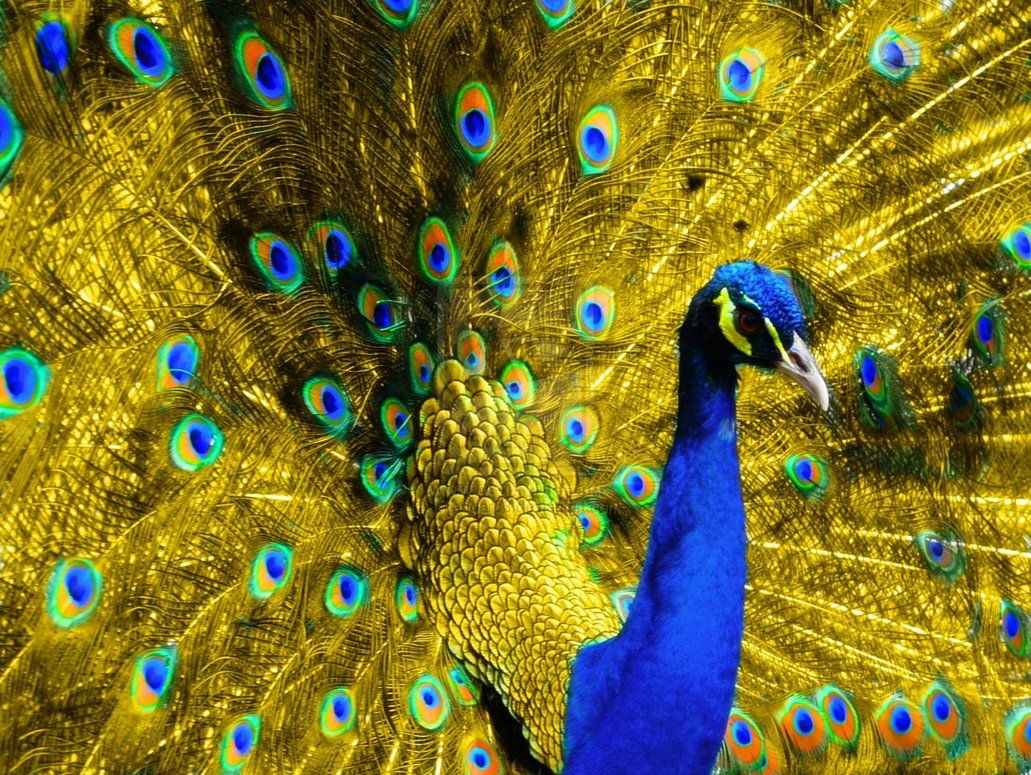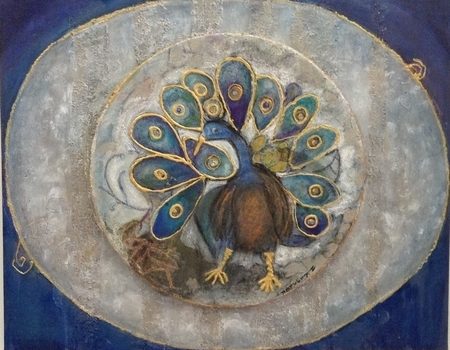Di goldene pave / The golden peacock
Di goldene pave
Iz di goldene pave gefloygn, gefloygn,
Un di nakht hot geefnet di goldene oygn,
Likhtiker mayner, shlof ayn.
Di nakht hot geefnet di goldene oygn,
Bin ikh fidl gevorn, un du der boygn,
Umruiker mayner, shlof ayn.
Bin ikh fidl gevorn un du der boygn,
Un dos glik iber undz hot farlibt zikh geboygn,
Un dos glik iber undz hot farlibt zikh geboygn,
Gelozt undz aleyn un farfloygn, farfloygn,
Troyeriker mayne, shlof ayn.
The golden peacock
The golden peacock has flown, flown off,
And night has opened its eyes of gold,
Bright one of mine, go to sleep.
Tsertlekher mayne, shlof ayn.
Night has opened its eyes of gold,
I was the fiddle and you were the bow,
Tense one of mine, go to sleep.
I was the fiddle and you were the bow,
And fortune, enamored, bowed down over us,
Soft one of mine, go to sleep.
And fortune, enamored, bowed down over us,
Left us alone, flew off, flew off,
Sad one of mine, go to sleep.
About “Di goldene pave”
 Birds are songsters, and, unsurprisingly, there are lots of songs about them in Jewish – if not most – languages. They are magical beings, mediating between heaven and earth, embodying our desires to fly free from the chains of mundane experience and to reach spiritual heights. They are small creatures, nestled in the branches of trees as our own babies are cradled within the home. For centuries, quills fashioned out of their plumes have enabled us to communicate with distant lands, and these feathers may embody the most wondrous of colours.
Birds are songsters, and, unsurprisingly, there are lots of songs about them in Jewish – if not most – languages. They are magical beings, mediating between heaven and earth, embodying our desires to fly free from the chains of mundane experience and to reach spiritual heights. They are small creatures, nestled in the branches of trees as our own babies are cradled within the home. For centuries, quills fashioned out of their plumes have enabled us to communicate with distant lands, and these feathers may embody the most wondrous of colours.
This webpage is devoted to one of the most beautiful birds of all, the “Golden Peacock” – “Di Goldene Pave” – the mythical symbol of Yiddish literature and song.1
Peacocks, with their golden “eyes” or “stars” and lustrous feathers, are in many ancient cultures symbols of the cosmos, all-seeing wisdom, immortality and light. In Greco-Roman mythology, the peacock is identified with Hera (Juno) who created the peacock from Argus, whose hundred eyes symbolize the vault of heaven and the “eyes” of the stars. Many Hindu deities are associated with the peacock, and in Buddhist philosophy, the peacock represents wisdom. In Babylonia and Persia, the peacock is seen as a guardian to royalty, and is often seen in engravings upon royal thrones; it is also associated with paradise and the tree of life. In Christianity, the peacock symbolizes the “all-seeing” church, as well as resurrection, renewal and immortality. (For more information, see these websites featuring peacock symbolism). The peacock also has negative connotations, with its raucous call and prideful bearing.
According to Buddhist folklore, Buddha-to-be “was once born as a golden peacock, residing on the golden hill of Dandaka in the Himalaya mountains. When day dawned, the golden peacock used to sit upon the summit watching the rising sun, and it composed a prayer to protect himself in his feeding-pasture. … In the evening when the sun went down, the bird came back to the hilltop on which he rested to watch the setting sun, and he meditated to utter another prayer to protect him from dangers during the night time.” (Read the parable here).
The Jewish “goldene pave” may possibly have descended from these antiquities – we don’t know (see some amusing anecdotes about the origins of folksongs here). We first hear of the mythical bird in two variants of Yiddish folksongs about an unhappy bride, banished from her parents’ home and sequestered in her mother-in-law’s domain. In Beregovsky’s collection of Jewish Folksongs (1938), the girl turns herself into a golden peacock and flies to her parents’ home; this is reminiscent of European ballads on the theme of the cruel mother-in-law. In Ginzburg & Marek’s anthology, Jewish Folksongs in Russia, 1901, the golden peacock, able to fly the impossible distance between the young bride and her parental home, functions as a messenger between the girl and her family. Russian folklorist Zinoviy Kiselgof (1878-1939) interpreted the folksong metaphorically: “‘Di gilderne pave‘ [the golden peacock] is an allegorical symbol of the Jewish nation and ‘Di gilderne feder‘ [the golden feather] means our Holy teaching, the Torah. ‘Shver un shvigers kest‘ [board with parents-in-law] is the existence in Golus [Exile], i.e., far from mother’s house.” (The reference in both variants to a lost feather is reminiscent of what happened to Pegasus, the mythical winged horse and inspiration of the Muses, when he was turned into a constellation). The loneliness of the new bride is a common theme in many traditional cultures. Here, for example, is a similarly-motivated Yemenite song, “Abdah“, sung by a new bride at the pre-nuptial henna ceremony: “Dear mother, I wish I were a bird that spreads her wings and flies to your doorstep.”
* * * * *
Versions
Jave Alberstein:
https://www.youtube.com/watch?v=0iqZe-Wo32I
Batya Fonda
Sabrina Gasparini
Mark Perlmuter
Maminka
Luba Claus
Johan Aben
Simcha Gilam
Sabrina Gasparini
Emlyn Hinton

